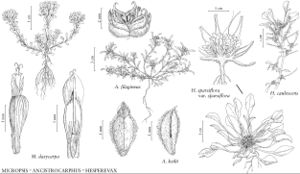Micropsis
in A. P. de Candolle and A. L. P. P. de Candolle, Prodr. 5: 459. 1836.
| Taxon | Illustrator ⠉ | |
|---|---|---|
 | Micropsis dasycarpa Ancistrocarphus filagineus Ancistrocarphus keilii Hesperevax sparsiflora var. sparsiflora Hesperevax caulescens | Linny Heagy Linny Heagy Linny Heagy |
Annuals, 1–10 cm. Stems 1, ± erect, or 2–7, ascending to erect [decumbent]. Leaves mostly cauline; alternate; blades oblanceolate to spatulate [± linear]. Heads borne singly or in pairs in dense [loose] spiciform [axillary] arrays or second-order glomerules. Involucres 0 or inconspicuous. Phyllaries 0, vestigial, or 1–5, unequal (similar to paleae). Receptacles flat to pulvinate (heights 0–0.3 times diams.), glabrous. Pistillate paleae persistent, ± erect or incurved, yellowish to brownish; bodies with 5+ nerves (nerves ± parallel, ± prominent), obovate to oblanceolate, open most of lengths (not enclosing florets); wings incurved. Bisexual paleae persistent or tardily falling, 2–7, erect (somewhat enlarged) in fruit, shorter than or equal to pistillate paleae; bodies broadly lanceoloid to oblanceoloid (saccate [involute], each enclosing a floret, apices 2–3-fid [entire or erose]). Pistillate florets [2–8] 15–30. Functionally staminate florets 0. Bisexual florets 2–7; corolla lobes 4 [–5], equal. Cypselae ± brownish, dimorphic: pistillate obcompressed, ellipsoid to obovoid (somewhat angular), incurved, not gibbous, faces densely strigose; bisexual terete, straight, faces sparsely strigose [glabrescent]; corolla scars apical; pappi 0 (simulated by hairs of cypselae) [coroniform].
Distribution
(possibly native) in s-c United States, s South America
Discussion
Species 5 (1 in the flora.
See discussion of Filagininae following the tribal description (p. 385).
Micropsis species occur in moist or dry, often sandy or alkaline habitats of Mediterranean to humid temperate climates. Other than a recently discovered population in the flora area, Micropsis is known only from temperate South America. It appears to be monophyletic, with ancestors possibly near Evax or Stuartina Sonder (J. D. Morefield 1992). Micropsis is most easily recognized by bisexual paleae enlarged, ± saccate, usually apically lacerate, often distally gibbous, resembling straitjackets tightly enveloping their florets and cypselae, and pistillate cypselae densely strigose (known in other Filagininae only in Old World Evax and relatives).